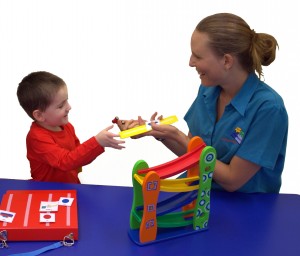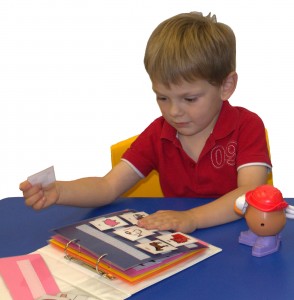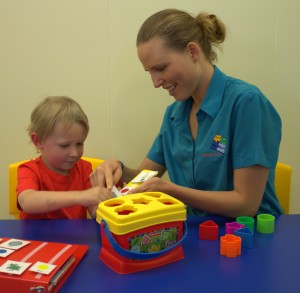
A number of the Talking Matters team went to PECS training this week, so almost all the team now have formal training in this. So what is PECS and how is it useful for kids?
Picture exchanging assists children to develop communication by giving an immediate reward for an attempt to communicate. Children learn how to communicate an inner desire, helping them to see the value of communication. The success in having their desires met is usually very motivating and results in children wanting to communicate more. Their frustration is also reduced, allowing them to concentrate on the model provided to them by their communication partner.
A picture exchange communication system (PECS) is a form of augmentative and alternative communication (AAC) that uses pictures to support words, to help children communicate.PECS was originally designed especially for children with autism who have delays in speech development, however is used very effectively for children with a range of communication difficulties.
When first learning to use PECS, the child is given a set of pictures of favourite foods or toys. When the child wants one of these items, he gives the picture to a communication partner(a parent, therapist, caregiver, or even another child). The communication partner then hands the child the food or toy. This exchange reinforces the child’s communication attempt. As the child begins to understand the usefulness of communication, the hope is that he will then begin to use natural speech. It is important the child receives the requested item quickly after making a request, so be careful in the items you select (e.g. you may wish to avoid lollies, chocolate, soft drink etc).
PECS may also help improve social interactions in children who experience difficulties in this area. Because the child is in charge of approaching the communication partner, the child learns how to make the first move. For children with communication difficulties, approaching another person socially can be difficult. However, with the support of aPECS system the child has the support of the picture to assist him communicate his needs, so the initial approach may be less intimidating.
There are no known negative effects of PECS. Some parents have been concerned that their child will become dependent on PECS and not move on to develop natural speech. However, this view is not supported by research studies. In fact, there is evidence that children who have learned to use PECS develop speech more quickly than those who have not been trained in PECS. A child can be trained in PECS by a parent, caregiver, or therapist.

PECS is usually taught in phases:
Phase One: The adult makes a list of the child's favourite items (often beginning with foods). One of these items is selected for the first training session, and a picture of the item is made. That item can be placed under a clear container, so the child can see it, but not get it. If the child looks interested in the item, one adult gives the child the picture card. Then the child is prompted (usually by holding his/her hand and guiding it) to hand the picture card to the other adult. Once the communication partner receives the card, the request is spoken aloud ("Oh, you want the cookie! You can have it!"). At this point, the requested item is given to the child.
Phase Two: The adult moves slightly away from the child so that the child has to move towards the adult to place the picture card in his/her hand.
Phase Three: The child is given more than one picture card. Now the child must choose which one represents a desired object, and then give this card to the adult. At this point, the child may be using a communication board or a binder in which to hold the cards.
Phase Four: The child is given a card with the phrase "I want ____" on it. This card now must be used with the picture card showing what is desired. The idea is that the child will learn how to communicate using complete sentences. Even children who cannot yet read can learn to recognize the words as symbols on the cards.
Phase Five: Before this point, the child has never been asked directly, "What do you want?" In this phase, the communication partner asks the child this direct question, and waits for the child to hand him/her a picture card. This builds the foundation for future communication when a parent needs to know the desires of his or her child.
Phase Six: Once the child can usePECS with fluency and has generalized the system to more than one communication partner, the child is taught how to comment on something s/he observes. The communication partner holds up an interesting object, asking the child, "What do you see?" at the same time pointing out the "I see ____" card. The child is then prompted to place the picture card representing the object next to the "I see ____" card. The parent then comments on the cards ("Yes! I see the airplane too"). In this way, the child learns how to communicate his or her observations and experiences to others.
Many children who are using PECS to get their communication started will not need to move beyond Phase Three. Some children for whom we usePECS initially will begin to use more words and no longer need the additional support thatPECS provides. Some children will however move on through the following phases.
PECS pictures can be made at home or with the help of the speech pathologist. Pictures may include:
- Digital photos, particularly of children doing preferred activities
- Pictures cut from magazines and glued on to card
- Labels from food or items
- Clipart pictures
- Boardmaker symbols (this is a computer program some speech pathologists ans schools use)
The pictures need to be accessible to the child and families may have different ways of using the cards in their home. Some suggestions include, but need not be limited to;
- Velcro the pictures to the fridge door in easy reach
- Keep the pictures in a box, basket or on a shelf that the child can access easily
- On a key ring the child can carry with them
- In a small notebook or photo folder

There are several well-designed research studies showing the usefulness of PECS. In one study of 18 preschool children with language delays, some of whom were diagnosed with autism,PECS generalized across communication partners and environments. Further, almost half of these children stopped usingPECS and started using natural speech within a year. One parent commented that "PECS turned on the light for communication" in her child. Similar results were found for two smaller, but still well-designed studies.
Charlop-Christy, M.H., et al. 2002. "Using the Picture Exchange Communication System (PECS) With Children With Autism: Assessment of PECS Acquisition, Speech, Social-communicative Behavior, and Problem Behavior." J Appl Behav Anal. 35(3):213-231.
Schwartz, I.S., et al. 1998. "The Picture Exchange Communication System: Communicative Outcomes for Young Children with Disabilities." Topics in Early Childhood Special Education 18(3):144-159.
Ganz, J.B., and R.L. Simpson. 2004. "Effects On Communicative Requesting And Speech Development Of The Picture Exchange Communication System In Children With Characteristics Of Autism." J Autism Dev Disord. 34(4):395-409.
To find out more about how PECS can help your child visit the PECS webpage. To find out more about how the
Related Blog Posts
If you liked this post you may also like:
Active communicators
Using TANGRAM PUZZLES To Grow
Word combinations
4 1/2 year olds



